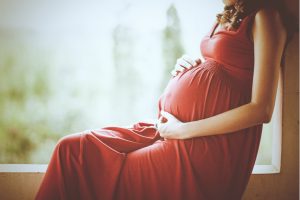
28-day cycle: enjoy the ride

Menstruation, ovulation, and cycle are probably terms that sound familiar to you. But do you know exactly what happens in your body when you’re on your period? Or when you are the most fertile? This is the 28-day cycle: enjoy the ride!
What is a menstrual cycle exactly?
During the fertile period in your life, so from your first menstruation until menopause, your body makes sure that you can get pregnant every month. It does this by developing a follicle, which is an egg cell surrounded by other cells. The hormones that it secretes thicken the lining of the uterus, so a fertilised egg can attach itself to it. If the egg cell isn’t fertilised, your body gets rid of the excess lining that is build up in the uterus and this eventually comes out through your vagina in the form of mucus and blood when you’re menstruating. The whole process is called the menstrual cycle.
Born with a million egg cells
The egg cells in a woman’s body are developed before she is even born. If someone is 20 weeks pregnant with a female fetus, then that fetus holds about seven million follicles. At the time of the birth, about one million follicles are left. When a girl gets her first period, which usually happens between the ages of 11 and 14, there are about 400,000 follicles present in her ovaries.
Average cycle of 28 days
The average menstrual cycle takes about 28 days. Not every body is the same however, so cycli between 25 and 35 days are considered normal as well. Below you can read what the different phases of your cycle look like step by step. A new cycle always starts on the first day of your menstruation.
The follicular phase of your cycle: the growth and release of the egg cell
The hormone FSH (follicle stimulating hormone) is responsible for the growth of several follicles in the ovaries. Women who go through fertility treatment therefore receive extra FSH at the fertility clinic. As the follicles grow, the estrogen level in your body increases. The follicle that grows the fastest will open first and release an egg cell. This is called ovulation. The maturing of a follicle takes about 21 to 45 days in (young) teenagers. In adult women, this process takes about 21 to 35 days.
”As the follicles grow, the estrogen level in your body increases.”
Ovulation takes place half-way through the menstrual cycle, when the largest follicle is about 17 to 20 millimeters large. 36 to 48 hours after reaching this size, the egg cell is released. It ends up in the abdominal cavity, after which it gets pulled in by one of the ends of the Fallopian tubes. Through the Fallopian tube, it eventually arrives in the womb. Here the egg cell can be fertilised by a sperm cell. On average, ovulation takes one or two days and usually occurs around the 14th day of your cycle. This is the moment that you’re at your most fertile. Keep in mind that sperm cells can survive in your body for five days, which means that you can also get pregnant if you have unprotected sex a few days before your ovulation.
Also read: Contraception method for women
The luteal phase of your cycle: from preparing your womb to your menstruation
The luteal phase starts after the follicle opens and the egg cel is relased. The follicle then changes into a so-called yellow body. It produces progesterone, which together with estrogen prepares the lining of the uterus for pregnancy by thickening the mucous membrane. During this phase, which takes 12 to 14 days on average, it’s possible that you develop premenstrual syndrome (PMS). This sometimes causes depressive symptoms or headaches. Some people experience fatigue or pain in the breasts. However, there is only a small percentage of women that suffers from PMS, probably around 5%.
Menstruation
If the yellow body isn’t supported by the pregnancy hormone hCG, then the hormone production stops. This leads to the breakdown of the extra thick mucous membrane in the womb. Your body removes it from your body together with the unfertilised egg cell, which causes you to bleed during menstruation. Menstruation lasts for 3 to 7 days on average.
Also read: Eco-friendly and organic menstrual products
Pregnancy
As said before, if you’re pregnant, your body produces the hormone hCG. This usually means that you stop menstruating while you’re pregnant, but it’s possible that you still lose a little blood at the start of your pregnancy.
Calculating your ovulation date
Are you trying to get pregnant and do you want to calculate when you’re most fertile? You can use an online calculator for this, like the Clearblue ovulation calculator, or apps that are specially created for that purpose. Simply fill in the number of days in your cycle and when your last menstruation started. You will have to keep track of this information beforehand. It’s also possible to take an ovulation test. You can buy these at websites like Clearblue or Sensitest, and you can also find them at your local pharmacy.
Reduced fertility
Because your egg cells have been in your body since before you were born, they age over time. This is the reason that you’re not as fertile when you get older. An average, a 20-year-old woman has only 20% deviating cells. By the time she’s 40, 80% of all her cells are deviating cells. This reduces the chance of getting pregnant and increases the risk of miscarriage.
Identical and fraternal twins
Sometimes it happens that a second egg cell is released and fertilised. The woman in question is pregnant with fraternal twins in that case. When a fertilised egg cell divides itself into two separate cells, the woman is pregnant with identical twins.
Deviations in the menstrual cycle
Many women don’t have a regular cycle. In extreme cases, this can lead to what experts call amenorrhea, meaning that a woman doesn’t menstruate for six months. There is also something called oligomenorrhea, meaning that someone has a cycle of more than 35 days, but less than six months.
Women with PCOS (Polycystic Ovary Syndrome) have small follicles in their ovaries that don’t grow or ovulate very well. These underdeveloped follicles are called cysts. The reduced or non-existing ovulation of a woman with PCOS negatively affects her fertility. It’s the most common hormonal deviation among women; an estimated 5 to 10% suffers from PCOS in a mild or more serious way.
20 to 25% of women who try to get pregnant are diagnosed with anovulation. This is the complete absence of ovulation. These women can still menstruate.
Some women have an increased chance of deviations, like professional athletes, women who suffer from anorexia, morbidly obese women, and women who breastfeed.
Do you have a question about the 28-day cycle? Let us know in the comments 📩








Respond or ask a question
0 comments